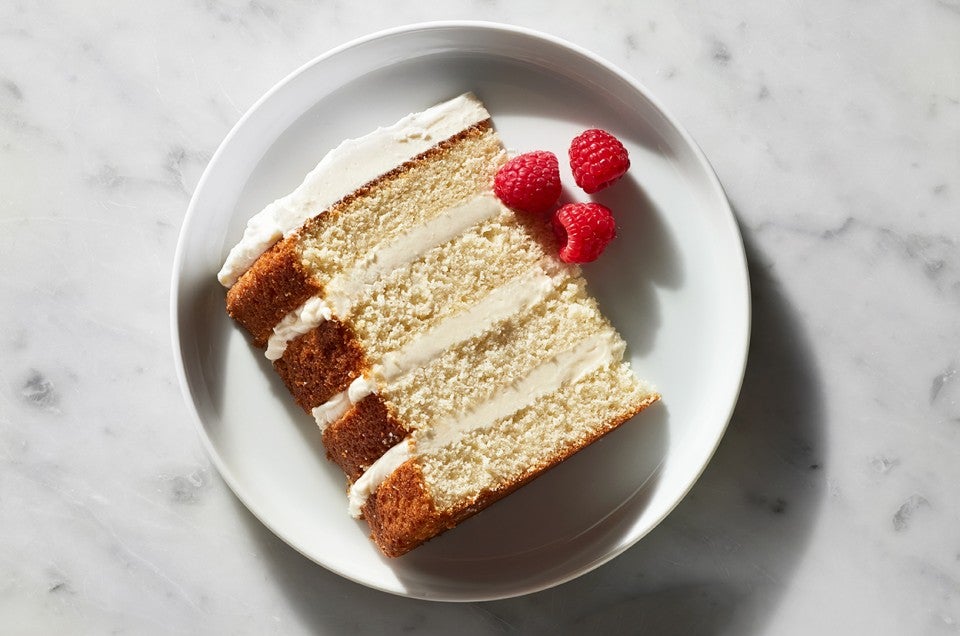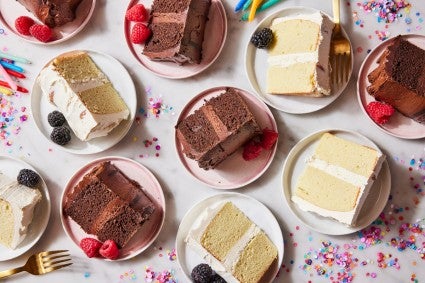How long does cake last in the fridge?
What about at room temperature: Here's how to store you cake to keep if fresher, longer.


Whether you want to save leftover cake after a big celebration or bake ahead and store cake for serving later, you may wonder: How long does cake last, and what’s the best way to store it? Read on.
The most important first step is keeping your cake from drying out. After it’s fully cooled, seal it in a handy cake keeper, under a cake dome, or wrap it with plastic wrap around its pan or platter so it’s airtight. If it’s already been sliced into, press plastic wrap directly against the cut sides before sealing the rest of the cake.
Where and how long to store your cake depends on what it’s made of and how it’s filled or frosted. Here’s a helpful guide:
| Cake, frosting, and/or filling | Store at room temp | Store in the fridge |
| Plain, unfrosted cake such as a Bundt cake, pound cake, or unfrosted cake layers | 2 to 3 days (our recommended method) | Up to 1 week |
| Frosted with American, Italian, or Swiss buttercream | Up to 2 days | Up to 1 week |
| Contains cream cheese or mascarpone in the cake (as in a cheesecake) or frosting | Do not store at room temperature | 3 to 4 days |
| Topped or filled with whipped cream, custard, or curd | Do not store at room temperature | 3 to 5 days |
| Topped or filled with fresh fruit or jam | 1 to 2 days | 3 to 5 days (our recommended method) |
If your cake incorporates a few different elements, default to the storage method and timeframe for whichever one is most restrictive. For example, if you made a plain vanilla layer cake frosted with American buttercream, but it has a lemon curd filling, it will need to be stored in the fridge for no more than five days.

Most cakes freeze quite well and can stay fresh-tasting from the freezer for up to a year (hence the wedding cake tradition!), though they’re usually best within three to four months of freezing. To freeze whole unfrosted cake layers or loaf cakes, first make sure they are cooled completely. If you’ll be freezing the cake for a long time, brush on a cake soak to ensure it stays moist. Then, wrap the cake tightly in a double layer of plastic wrap and transfer to the freezer. To defrost, let the cake thaw in the refrigerator overnight before frosting or serving.
For frosted, fully assembled cakes, once you've applied the final layer of buttercream, chill the cake for at least 30 minutes, until firm to the touch. (Meringue-based buttercreams don't need to be covered for this step, but American buttercreams do.) Double wrap the cake with plastic or foil and freeze for up to one month. Thaw overnight in the fridge, still covered. The next day, remove the wrapping and let come to room temperature before serving.
For leftover cake, it’s best to cut the cake into individual slices before freezing. Cover both cut sides of each slice with a slip of parchment paper, then lay the slices on a baking sheet and freeze for a few hours, until firm. Once frozen, wrap each slice in a layer of plastic wrap followed by a layer of foil, then store in a zip-top bag or other airtight container. To defrost a serving (cake on demand!), unwrap the slice, place on a plate, and let thaw in the fridge until soft. Then, let it warm up a bit at room temperature and enjoy.
Learn more essential cake tips and tricks in our guide on How to Bake Cake.
Cover photo (Tender White Cake) by Mark Weinberg; food styling by Liz Neily.


